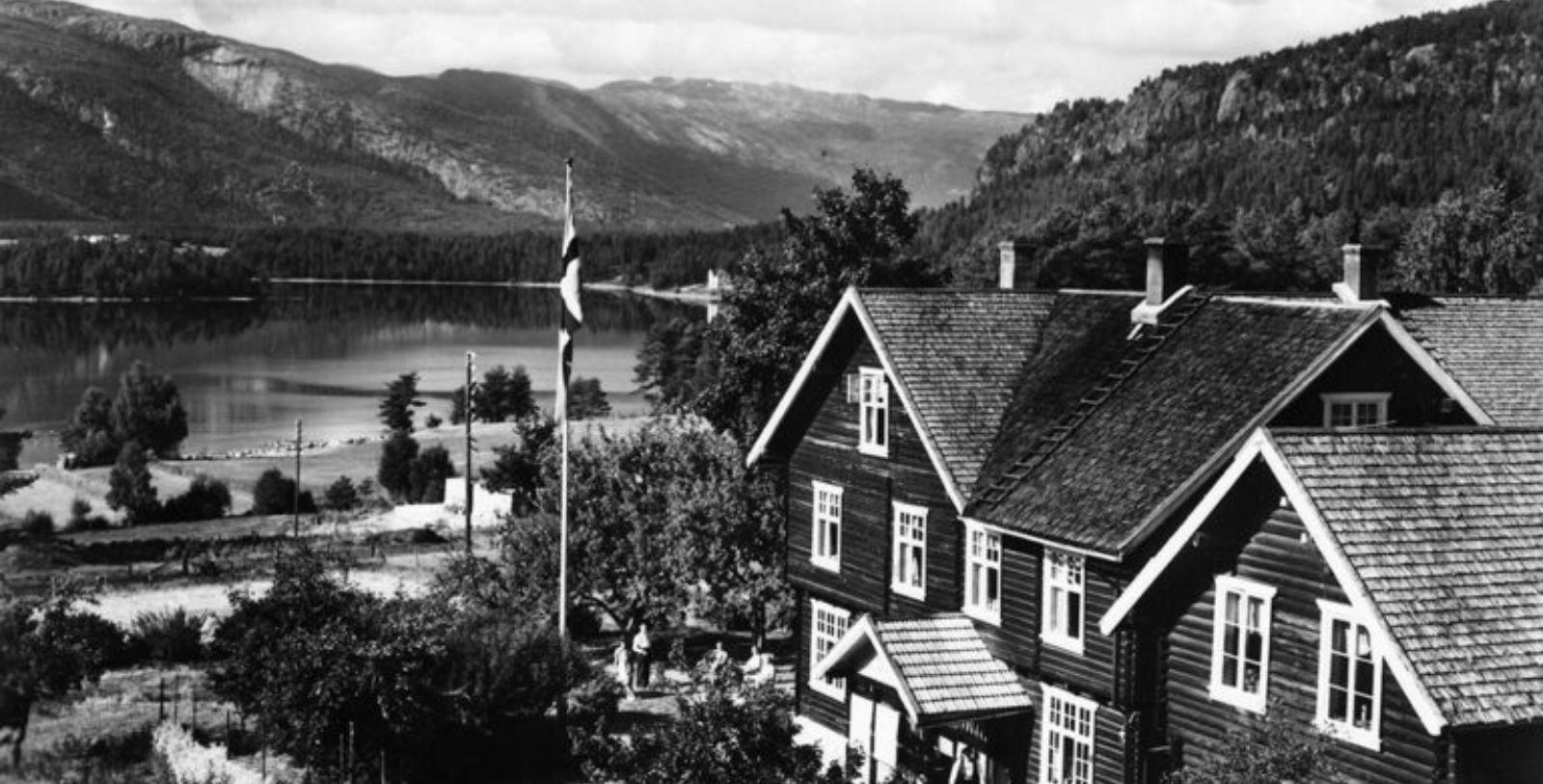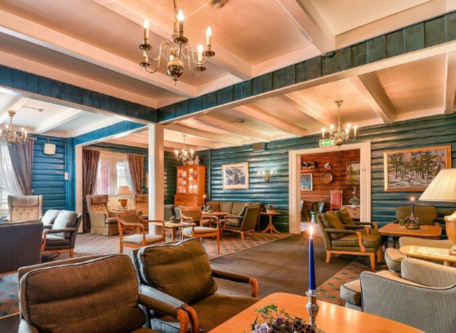Receive for Free - Discover & Explore eNewsletter monthly with advance notice of special offers, packages, and insider savings from 10% - 30% off Best Available Rates at selected hotels.
history
Discover the Straand Hotel, which resides near the shorelines of two majestic lakes, the Vråvatn and Nisser.
In 1864, married couple Olav and Kari Straand purchased a parcel of land in the pastoral village of Vrådal. Rugged in character, the two developed the plot into a sprawling homestead centered on a quaint country farmhouse. The home itself featured a loft, kitchen, and modest living room that the couple used to entertain. However, maintaining the farm was a difficult task, especially given the rough terrain and short growing season. But Olav and Kari adored their farm nonetheless and endeavored to make it a success. Looking for other ways to support the homestead, Olav eventually decided to clear some of the surrounding pastures to open a bus station. At the time, reliable transportation for the residents of Vrådal was a rare commodity due to the steep mountainous landscape. Olav's bus station thus offered a precious public service, which quickly grew in popularity. The business became so prosperous that some travelers had even started seeking overnight accommodation inside the Straand farmhouse. Olav and Kari set about converting parts of their living room into makeshift sleeping quarters while the family temporarily moved into the kitchen. Despite the cramped conditions, the Straands managed to charm their guests with their attentive hospitality. Kari, in particular, was a skilled cook whose homemade Norwegian dishes were well-received among the tenants. Word of the Straand family's bus station subsequently spread throughout the region, inspiring more people to seek out its inviting ambiance.
The steady increase in visitation eventually enabled the Straands to evolve their once quiet home into a fully operational boarding house. They installed a variety of new structures to help provide a better experience, including the creation of a large stable capable of housing more than a dozen horses. The renovations proved a wise investment, as they helped sustain the bus station's venerable reputation for many years thereafter. In fact, business continued to be incredibly strong when Olav and Kari's son, Johan, assumed managerial responsibilities in 1902. Preserving the standards established by his parents, Johan and his own wife, Sigrid, masterfully watched over the bus station throughout the early 20th century. Perhaps the most significant development during their tenure was the emergence of Vrådal as a tourist destination. As the area's only lodging, foreign vacationers had begun staying at the boarding house to explore the village and its two neighboring lakes, Vråvatn and Nisser. The location thus reached new heights of prosperity, which seemed destined to last forever. But tragedy struck when a structural incident affected the entire complex in 1924. Nevertheless, the Straand family was undeterred and resolved to restore their beloved facility. They quickly went to work upgrading the bus station to host modern automobiles while also transforming the boarding house into a conventional hotel. After months of continuous construction, the Straands triumphantly reopened the complex the following Christmas.
Known as the "Straand Hotel," the former boarding house featured many fantastic amenities. A combination of gorgeous Swiss-themed architecture and Norwegian structural motifs constituted the building's new exterior façade, brilliantly reflecting the regional alpine environment. Much to the delight of the Straand family, the complex soon returned to being an incredibly popular retreat. Sigmund Straand became the primary owner of the compound in 1948, leaving it to his son a decade later. Now in its fifth generation of ownership, the Straand Hotel complex experienced incredible growth during the 1970s and 1980s. The Straand family engaged in numerous projects that included the creation of several outstanding guest cabins and the acquisition of a private beach nearby. The Straand Hotel itself underwent many dramatic changes, as well. A wealth of new facilities specifically debuted in the building, such as a dance bar, wine cellar, conference center, and 125 guestrooms. The renovations ultimately elevated the entire site into one of Norway's most prominent vacation destinations—a status it still enjoys today. Lars Arne and Katherine Straand have managed the hotel since 2019, continuing their family's historic role as the stewards of this iconic destination. They remain steadfast in their commitment to preserving the rich institutional legacy Olav and Kari Straand established generations ago.
-
About the Location +
Located a few hours west of the Norwegian capital, Oslo, the quaint village of Vrådal is in the county of Vestfold og Telemark—specifically its historic district, "Upper Telemark." (Telemark is named after the "Thelir," a North Germanic tribe that settled the area throughout the European Migration Period of the early Dark Ages.) The county itself resides on the western fringes of Eastern Norway, one of the country's most culturally vibrant areas today. Like the neighboring regions of Western and Southern Norway, Eastern Norway's most well-known historical era coincided with the rise of the Vikings—a seafaring people active across Europe during the Middle Ages. Technological innovations in Norway's western counties effectively increased local agricultural activity and, thus, the size of its population. New land to distribute became increasingly rare, forcing the inhabitants to look to the sea for opportunity. Using a uniquely slim, single-mast vessel now known as the "Scandinavian longship," hundreds of people subsequently departed Eastern Norway to distant destinations. One common practice of the Vikings was to raid the shoreline of Europe for resources. Some of those warriors succeeded in carving out feudal fiefdoms—including powerful kingdoms—within the areas they conquered. But many others peacefully interacted with different European societies, establishing trading posts throughout the continent. The Vikings were even known to harbor merchant colonies as far away as central Russia and the Middle East. Adventurous bands of Vikings also sailed for long distances to remote landmasses like Iceland and Greenland, which they settled starting in the 10th century. In fact, archeological evidence has revealed that the Vikings managed to colonize Newfoundland, calling the location "Vinland" in contemporary accounts.
While the age of the Vikings has long since ended, many sites around Eastern Norway still preserve the rich history they left behind. Several prominent attractions reside along the regional coastline near the mouth of the Oslofjord, such as the Kaupang Viking Town, the Slottsfjells Museum, and the Midgard Vikingsenter. But modern Eastern Norway is also a popular tourist attraction due to its wealth of natural wonders. Vrådal is even near two of the region's most renowned lakes, Vråvatn and Nisser. Numerous other lakes are located nearby, too, such as Bandak, Kviteseidvatn, and Flåvatn. Many travelers from across the world thoroughly enjoy visiting those lakes, which are all conveniently connected by way of the historic Telemark Canal. (Dating back to the late 19th century, the canal consists of 18 lock mechanisms, the most distinctive being the staircase lock "Vrangfoss.”) Perhaps the most popular method to navigate the 65-mile-long canal is on a couple of equally timeless boats known as the M/S Henrik Ibsen and the M/S Victoria. Even grander natural landmarks, such as the southeastern border of the famous Hardangervidda National Park, are situated a bit further away. The largest national park in all of Norway, this vast mountain plateau is a favorite site for cultural heritage travelers who adore hiking, cycling, and fishing. Eastern Norway's landscape has even become a prominent destination for extreme sports, most notably an activity called "Telemark skiing." Telemark skiing emerged when local alpinists began challenging one another to race down the area's mountainous terrain at the height of the Victorian era. Traversing the densely wooded paths took great skill, leading to the skiers inventing special maneuvers like the now-commonplace "free heel" turn. Many locations across Eastern Norway are now prime sites for this exciting form of skiing, with some practitioners even pushing for it to become a recognized Olympic event.
-
About the Architecture +
When the Straand family first debuted the hotel at the end of the 19th century, they specifically chose Norwegian vernacular architecture to help craft its appearance. Norwegian vernacular building themes—colloquially called "byggeskikk"—specifically drew inspiration from generational construction techniques that harkened back centuries. Until the onset of the 20th century, most structures throughout Norway were agricultural in nature. They typically resided deep in the wilderness and made use of whatever resources were available. Norwegian families thus developed hardy log cabins that were tightly latched together with corner notches to protect against the elements. Those houses also featured rustic architectural designs inside, including open-hearth fireplaces and stone chimneys. However, a few communal structures spawned more eloquent designs, such as the iconic medieval "stave church." Stave churches were typically designed using a type of wooden timber framing known as "post and lintel" construction, in which widely spaced vertical posts supported horizontal ones. Steeply pitched roofs reinforced by several intricately laid beams further characterized the overall design of the stave churches. Prominent dormers and steeple towers occasionally crowned the structures, too, in a manner reminiscent of more conventional Romanesque-style churches elsewhere in Europe. Great portals even guided visitors into the interior, which instilled a sense of awe with a variety of rich ornamentation connected to Norse iconography and the local alpine landscape. (Some of the symbols employed drew upon ancient motifs centered around dragons and serpents.)
However, the Straand family had also constructed the hotel to resemble aspects of a Swiss chalet. Swiss chalets were once rustic cottages that first emerged as seasonal farmhouses around the height of the Middle Ages. Indeed, the chalet was a refuge for Swiss cattle herders, who would bring their livestock up into the Alps during the warmer months. The house itself functioned as a secondary home, within which the farmers would create various dairy products for trade. But the chalets lost their original purpose as time passed, gradually turning into quaint seasonal vacation homes. The main reason behind the transformation was the emergence of the Alps as a popular tourist destination in the 19th century, specifically among the British and the French. They eventually discovered the many chalets scattered around the country and began buying them up in great numbers. The foreigners subsequently renovated the chalets to reflect their romanticized views of alpine life in Switzerland. Soon enough, the new iteration of the chalet had swept across the country. Many natives went as far as to alter their own homes to resemble the aesthetic, essentially making the architecture "Swiss" in the process. Many large-scale commercial buildings in Switzerland eventually showcased the style, too, including restaurants, storefronts, and hotels. A few Swiss construction companies even created premade chalets for people in other nations throughout Europe, especially in Scandinavian countries like Norway. The chalets—and their spinoffs—were typically very beautiful despite the rusticity of their layout. Set upon a rectangular foundation, the buildings were most easily recognized for their gabled roofs and facades of carved wooden details.


























